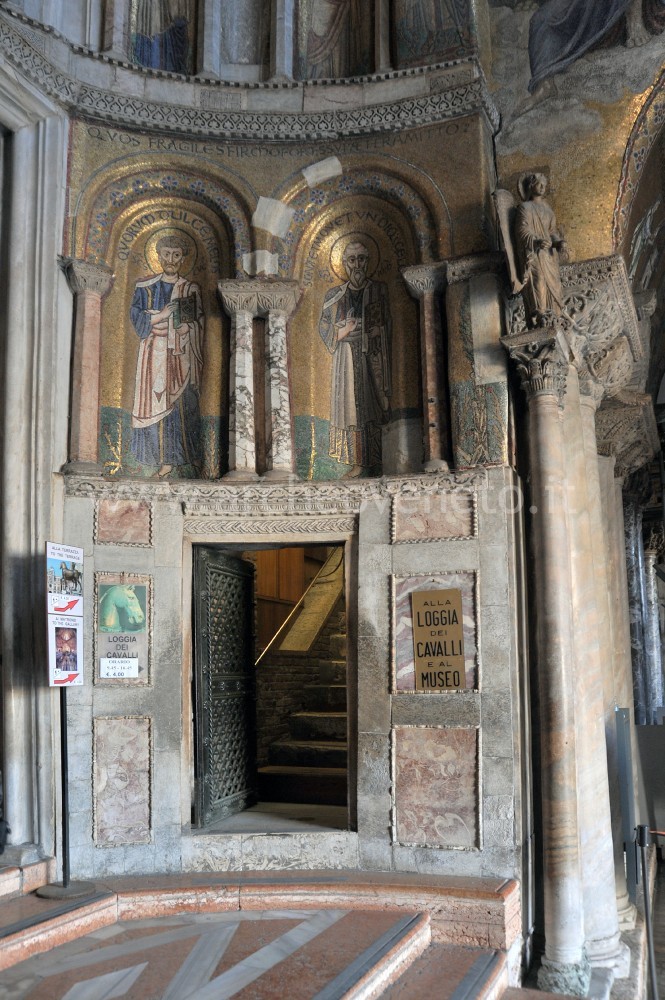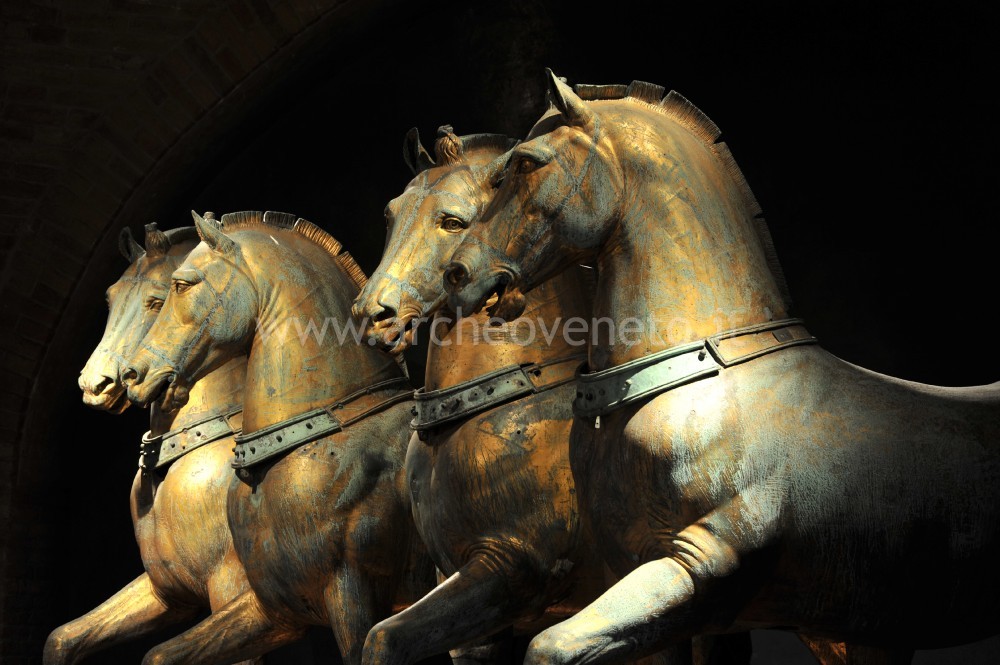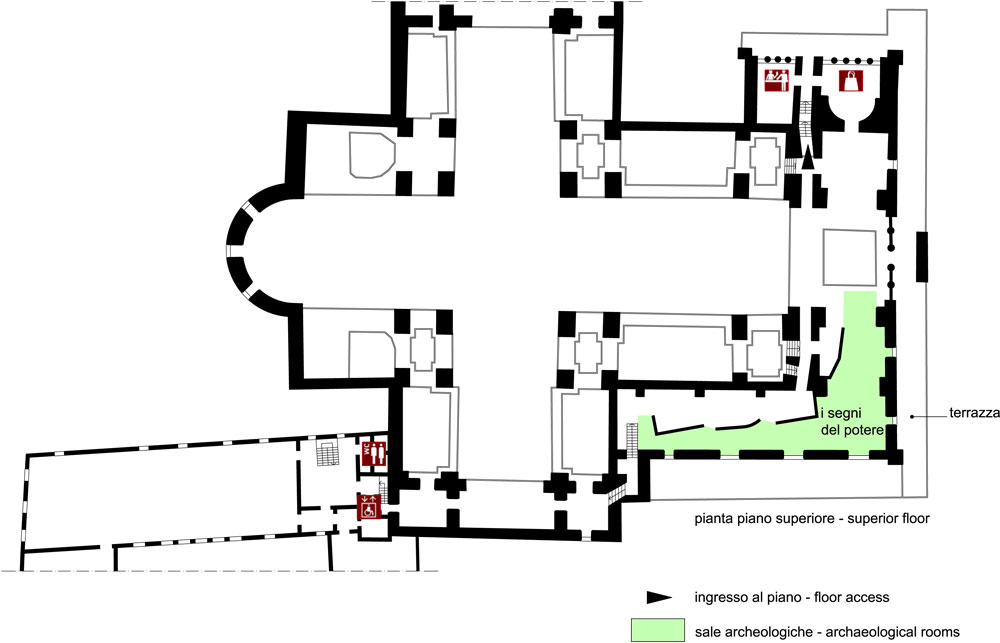|
|
File
San Marco Museum – Venezia
|
San Marco 328 (Basilica di San Marco) – 30100 Venezia (VE)
– Fax 041 2708334 |
  |
|
Summary

The San Marco Museum is rightly considered a part of the basilica devoted to the patron saint of Venice, since it is located on the upper floor of the building (enabling visitors to enjoy a beautiful view from above); it contains a set of artefacts that are closely linked to the history, architecture and decoration of the basilica itself. In the section devoted to antiquity, it is possible to see the extraordinary group of horses in gold plated bronze, coming from Constantinople, which were once on the façade of the cathedral, before being replaced by replicas.
Collection history
The establishment of the San Marco Museum, already hoped for in the late 19th cent., dates back to 1927 under the supervision of Luigi Marangoni. In the late 50’s the museum was enlarged and since 1982 it has been hosting the horses that until 1977 had been placed in the loggia on the façade of the cathedral, before being replaced, for conservation purposes, by accurate bronze replicas that are very faithful to the original. The latest re-arrangements of the exhibition were carried out in 2003.
|

 The section devoted to the “signs of the power” contains some archaeological artefacts dating back to late Antiquity and the early Middle Ages, as well as the famous horses of Saint Mark. The section devoted to the “signs of the power” contains some archaeological artefacts dating back to late Antiquity and the early Middle Ages, as well as the famous horses of Saint Mark.
The exhibition starts with a set of fragments of pluteuses and of decorated marble slabs dating back to a time span between the 5th-6th cent. and the 10th-15th cent. A.D.; the stone fragments provide an example not only of the types that can be seen inside the cathedral, but also of the whole architectural heritage of late Antiquity and middle Byzantine period.
Then there are five marble architectural elements, which display clear typological features: composite capital (5th cent. A.D.); two capitals from Constantinople (first half of the 6th cent. A.D.); Corinthian capital (2nd-3rd cent. A.D.); fragment of a cornice (11th-13th cent. A.D.).
At the bottom, in the corner, it is possible to admire the extraordinary group of gold plated bronze horses, which was once on the façade of the cathedral and which has now, after a complex renovation, been replaced by faithful replicas for conservation purposes. The horses come possibly from the Hippodrome of Constantinople; in 1204 they were sent from here to the Venetian Arsenal first and then to Saint Mark’s basilica. It is the only example of four-in-hand produced with the lost-wax casting technique that has come down to us. For long time the dating has been uncertain; the various hypotheses covered a period stretching from the 4th cent. B.C. to the 4th cent. A.D.; finally the carbon 14 analysis has enabled scholars to reduce this margin, stating that their production dated back to the early 2nd cent. B.C.
|

 The loggia of the cathedral, the place where the original quadriga that has now been moved inside the museum was placed, hosts the replicas of the four gold plated bronze horses. In the south-western corner of the balustrade, from which visitors can enjoy an extraordinary view of the sea, it is possible to see the so called Head of Carmagnola (6th cent. A.D.): it is a red porphyry portrait of Justinian I coming once again from Constantinople; also the porphyry sculpture of the Tetrarchs, which can be seen in the external part of the cathedral, in the corner with the Treasury Tower, was sacked from a palace of the great eastern capital city. The loggia of the cathedral, the place where the original quadriga that has now been moved inside the museum was placed, hosts the replicas of the four gold plated bronze horses. In the south-western corner of the balustrade, from which visitors can enjoy an extraordinary view of the sea, it is possible to see the so called Head of Carmagnola (6th cent. A.D.): it is a red porphyry portrait of Justinian I coming once again from Constantinople; also the porphyry sculpture of the Tetrarchs, which can be seen in the external part of the cathedral, in the corner with the Treasury Tower, was sacked from a palace of the great eastern capital city.
|

Admission: Negli orari di apertura
Ticket: Si
Price: Full fare: 4€; reduced fare: 2€ (only for groups of more than 15 people).
 School access School access
 Disabled access Disabled access
Before the visit we suggest you call the phone number: 041 2708311 to agree the entrance with the staff.
Opening Days
| Tipology |
When |
Specs |
| Summer/Winter |
Monday |
9.45-16.45 |
| Summer/Winter |
Tuesday |
9.45-16.45 |
| Summer/Winter |
Wednesday |
9.45-16.45 |
| Summer/Winter |
Thursday |
9.45-16.45 |
| Summer/Winter |
Friday |
9.45-16.45 |
| Summer/Winter |
Saturday |
9.45-16.45 |
| Summer/Winter |
Sunday |
9.45-16.45 |
Recommended tour time (minutes): 20
 Toilet Toilet
 Bookshop Bookshop
 Guide a stampa Guide a stampa
Catalogo
Audio guide
Italian. Audio guides temporarily out of order.
 Information boards Information boards
Italian and English
 Captions under exhibits Captions under exhibits
Italian and English
 Multilingual ads: Inglese Multilingual ads: Inglese
Panels and captions.
| I cavalli di San Marco, Catalogo della Mostra (Venezia 1977) 1977, Venezia. |
| Galliazzo V. 1981, I cavalli di San Marco, Treviso. |
| I cavalli di San Marco 1981, a cura di Perocco G., Zorzi R. , Milano. |
| Forlati Tamaro B. 1982, Ancora un’ipotesi sui cavalli di San Marco, in Atti dell’Istituto Veneto di Scienze, Lettere ed Arti 141, pp. 1-15. |
| Galliazzo V. 1984, I cavalli di san Marco: una quadriga greca o romana?, in Faventia, 6/2, pp. 99-126. |
| Il Museo di San Marco (catalogo) 2003, a cura di Favaretto I., Da Villa Urbani M., Venezia. |
| Il Museo di San Marco (guida) 2004, a cura di Favaretto I., Da Villa Urbani M. , Venezia. |
|

